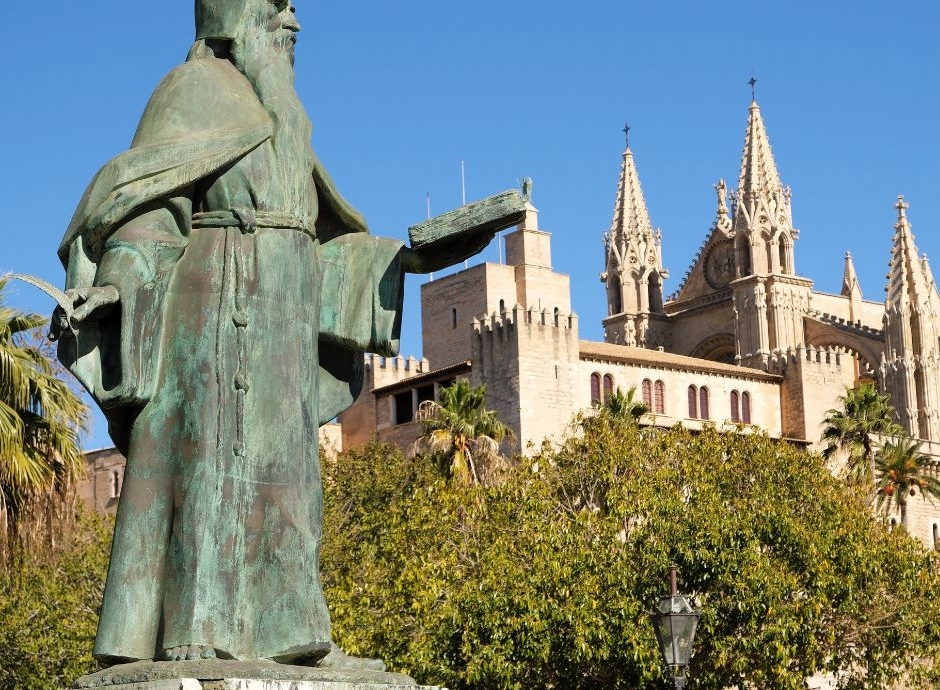
The figure of Ramon Llull, Bridging legend and reality
Religious figure, theologian, philosopher... alchemist? Amidst the intersection of reality and legend, Ramon Llull's legacy has not been adorned with the glossy veneer of "modern marketing" enjoyed by authors like Shakespeare in England or Dante in Italy.
Llull was one of the most influential Christian authors of the European Middle Ages. His work was groundbreaking, his projects remarkable, and he was among the first to insist that knowledge should be conveyed in the language of the common people, abandoning Latin, which only a small elite understood.
Born in Mallorca to a Catalan bourgeois father who had settled on the island, Llull initially reveled in the idle life of the court, with its festivities, luxuries, and vices. However, one day, he experienced a vision of the crucified Jesus and underwent a radical transformation.
Legends Surrounding Ramon Llull
Legends abound about this medieval genius, often regarded as a great magician by many, even appearing in one of the Chocolate Frog cards from Harry Potter.
He was not a magician, but the legend of the alchemist was forged during the medieval era. It is said that he was knowledgeable in Kabbalah, cartography, and navigation, and that he crafted perfumes and drugs. A mere rumor was enough to weave magic around the figure of Ramon Llull.
As a purported alchemist, it was also rumored that Llull had created the elixir of eternal life. However, since his beloved had an incurable illness and refused to take the potion, she died, leaving him alone with many years of life ahead of him.
Devastated by the death of his beloved, the supposed alchemist decided to travel—and evangelize—throughout the known world. Much later, far beyond the typical lifespan of the medieval era, he met his demise in a square in Tunis, lynched by the attendees while preaching the gospel.
There is some truth intertwined with this legend. When Ramon Llull received his enlightenment, he decided to retreat to the monastery of Randa. At that time, he was already mature for his era, being 30 years old. Nonetheless, he spent a considerable time as a hermit in a cave before embarking on his worldly travels, events that further fueled popular imagination.
Recently, one of Llull's inventions has prompted mathematicians and computer scientists to recognize him as a pioneer of artificial intelligence. He was the inventor of Ars Combinatoria, a machine for storing memory that he hoped would eventually think for itself.
The device had its own language, with an alphabet of nine letters (BCDEFGHIK) and ten scrolls of parchment on the right for questions, and another ten on the left for answers. Its structure is reminiscent of early computer disks.
Reality, Blended with Myth
The reality is that Ramon Llull was a visionary of his time, knowledgeable in many disciplines, a precursor of the Catalan language and grammar, a philosopher, a writer... After his voluntary retirement, he believed his mission was to preach the gospel, and he devoted himself enthusiastically to that task, traveling throughout the known world.
He wrote over 250 works on science, liberal arts, fictional and poetic texts, and theology, and he was deeply interested in the workings of logic and thought.
Beyond his appearance in the wizarding world saga, his fame as an alchemist, his heartbreak, and his ingenious inventor aspect, often compared to Leonardo da Vinci, or vice versa, it is worth pausing by the statue of Llull at the beginning of Sagrera Promenade in Palma and discovering more about the bearded man who seems to be preaching, or about to begin writing, from on high.




